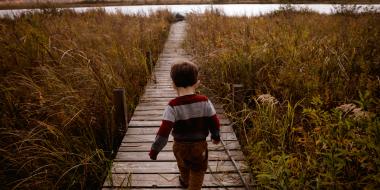As a parent, it’s hard to let your child experience life’s hardships, full of big (and small) disappointments, losses, and failures. Although the science of child development suggests that these experiences are not only good for kids, they’re actually essential for healthy growth and development, it can be tough to convince yourself of this as you stand by watching your child suffer. As a parent who watched her own child struggle, I understand this position intimately.
My youngest son could be described as intense and sensitive. He has a beautiful, big mind, and an enormously compassionate heart, which can make the daily experiences of life overwhelming for him at times. I knew entering school was going to be interesting for him, and shortly into his kindergarten year it became clear that interesting meant very challenging. He started to have meltdowns every morning and became behaviourally difficult at home. His little boy sparkle was increasingly absent. I knew school was too much for him, but what was to be done? If I just pulled him out of school, would I be teaching him that it was okay to give up when things got hard? But if I left him in a situation that wasn’t working for him, would I damage him in profound ways? Was it just an age thing he would overcome or was there something more considerable that I had not yet figured out? I’ll return to this later.
Parents today have access to an incredible amount of parenting information, keeping us informed on the perils of doing it wrong and of the boost we give our kids when we get it right. More than ever, we are aware that how we engage with our child shapes who they become. You would think that with all of this, we big people would be really well-positioned to capably and confidently step in as guides for our children, leading them through their developmental journey.
Are you a "snowplow" parent?
Often, however, it goes a little sideways. All of this information at our disposal has us questioning our intuition and second-guessing what’s best for our children. This insecurity inadvertently leads us to do just that by diminishing or erasing our child’s experience of hardship in a way that doesn’t serve their development--sometimes referred to as "snowplow parenting". So when the moment comes for us to say “no” or deliver bad news, we falter and say “yes” instead, or anxiously try to soften potential disappointment. It is at this point that parental withering and uncertainty collide to become a significant problem for the child’s development.
Children need to experience failure, upset, and the futility of the things in life that don’t go their way. Facing challenges repeatedly spurs growth, and in that growth resilience is developed. Much like strengthening a muscle through continual flex and stretch, resilience needs to be exercised in order to reach its potential. Thus, only when children get to endure the upset of life and come face-to-face with the dark will they be driven to consider alternative outcomes, learn to cope, and find the light at the end of it all—a space of emotional rest. As Carl Jung once said, “The word ‘happy’ would lose its meaning if it were not balanced by sadness.”
Why do we hinder those hard knocks?
Too tired, too busy
Sometimes parents avoid allowing their child to experience difficulty because, quite simply, they’re exhausted. Parents feel so much pressure to ensure that their children engage in both educational and extracurricular activities in order prepare them for a successful future that the financial realities often have both parents working outside the home to help facilitate this. And the burden to “do better because we know better” has parents rushing around reading every parenting resource available, trying to apply said suggestions for optimal outcome. How exhausting! It makes sense that, for the over-extended parent, if the choice exists between denying the child (and dealing with a big meltdown) or saying “yes” to ensure a compliant child, then “yes” it shall be! Even if “no” is what it really should have been. After all, what bossy children really need is a parent to lead.
Baggage claim
Parents might also choose to avoid unsettling their child because they are being run by an unacknowledged “program”. Everybody has these programs. They are scripted from our own childhood and our experiences of being parented. In avoiding conflict they might be affirming the insecurity that they will never be enough, or feeding into the need to keep everyone else happy to in order to feel okay. When we become parents, we find ourselves reverting back to these scripted programs so that, when faced with a child who is angry or sad, we rush in to make it right, so no one gets mad at us, so we can feel like we’re enough.
Ye of little faith
Parents can fall into the trap of overly protecting their children because of a lapse of faith in the developmental process. We humans are a hearty species and built not only to survive, but in fact to thrive in the face of adversity. We don’t drown with the first drop of rain, and are not blown over by the first gust. The developmental process is a spectacular one and when we can trust it, we are freed to bear witness to our children’s incredible potential for rising above, pushing through, and conquering life! However, when we lose faith in this process, we may bend and fix and soften in ways that fail to serve the healthy development of our children. Our job as parents is to understand what is developmentally appropriate for our child, for their stage of development. This is not always easy as each child is unique, and it is up to us to tweak where we set the bar for our child: too high – too much failure; too low – not enough.

Climbing the rungs to resilience
Knowing a little about the stages children grow through as they become resilient beings can often provide exactly the affirmation that parents need in order to feel confident shifting from rescuer to guide.
0 to 2 years
For the first two years of life, brain and emotional development for your child are such that there is almost no capacity for them to independently move from frustration and upset to resolution. Rather, adults are meant to be the child’s compassionate and external co-regulator. It is essential during this stage of growth that your child has you close at hand as a support while she rides out the storms of life. Let your child lean into your comforting presence as they weather these storms, even if they rage back. Especially if they rage back.
As your child approaches two years of age, expect those bouts of frustration and upset to grow. Neurologically, a child of this age is unable to control their temper, which is why you must continue to externally assuage those outbursts with a loving presence. You don’t need to fix the situation, but rather come alongside with a soothing voice, gentle touch, and eye contact that all communicate an inherent understanding and acceptance of your child.
3 years to early school age
From approximately three years up to early elementary school age, your child now has the neurological capacity to move from the big mad of the toddler years to the big mad and sad of the preschooler and early elementary years. As your child experiences failure and disappointment in this stage of life, there will still be the initial push-back of mad and, with your continued empathic presence, you will see that your child will more frequently begin to soften out of mad and move into sad. This can be especially heartbreaking for parents to observe, but it’s important to remember that it isn’t necessarily something that needs to be fixed by you. Instead, take (and give) comfort in each situation where your child gets mad then softens to sad as it is simply another wonderful opportunity for growth playing out before your very eyes.
5 to 12 years
Around 5-years-old, starting at very low levels and gradually increasing in fluency through to about age 10-12 years, you will observe your child starting to do on their own what you have been supporting them to do from the outside all along. That is, there might be some tempered anger and sadness, and then this will be followed by an internal acceptance and resolve.
A little mantra I offer to my clients:
I accept what cannot be changed.
I may not like it.
I may feel mad or sad about it.
And I resolve to persevere.
Enter resilience. It is at this stage that you will see tangible evidence of your child being able to hold onto herself during moments of upset and disappointment. Of course, with more intense situations and big emotions, your capable support and presence will be required for years to come. And as your child continues to experience the exquisite pains and pleasures of life, you will continue to observe their brilliant growth, exactly as nature intended. Help your little one learn responsibility, skills and self-reliance with these age-appropriate chores for kids aged 18 months to 12 years.
Too much vs not enough
In all of this, don’t be misled into thinking that you need to engineer experiences of failure to better prepare your child or “teach them a lesson.” Life will very naturally rain down quite enough without your help. Your challenge is to support them through these eventualities rather than always stepping in to rescue.
Of course, there may also be times when you need to step in to shield your child. While the vagaries of life are meant to be experienced, children are not meant to be washed out to sea in a tidal wave of adversity. If you have a very intense or sensitive child, if he is experiencing a significant life change like the birth of a sibling, divorce/separation, or a move, then consider that since these things are already providing incredible potential for growth and resilience, it may be appropriate for you to step in and alleviate some of the stress.
You are the expert on your child. Only you make the call about when it is all too much and when it is exactly right.
In my situation, I knew I was the expert for my boy who was struggling. I watched his difficulties intensify through kindergarten and Grade 1. And although I increased my efforts to have him be fully understood as a learner, he began to suffer from headaches and nausea, vomiting on a regular basis. Towards the end of Grade 1, I realized he was about to be swamped in his own flood of overwhelming failure, so I removed him from the classroom for the last two months of the school year to give him four months of respite before gradually re-entering the classroom in Grade 2. His learning profile was eventually formally assessed and he was discovered to be a child who was intellectually bright, but who didn’t learn in the same manner as other children. He continued to have ups and downs with teachers that understood him and those that didn’t. By grade 5, I decided to move him to a school designed for kids like him and he landed brilliantly. He is thriving in that environment and is a shining example of resilience.
It wasn’t a straight line to get him there. There were times when I’m sure I overstepped to protect him and other times when I didn’t do enough. The overall path, however, was one of inviting him to lean on me as his capable guide, and of stepping in to support during his upset and frustration. In all of that, I needed to make sure I navigated my own discomfort with his struggles so as to not have my program, my needs, and my worry about him override his necessary developmental journey. Like a driver constantly correcting the steering wheel, the quicker I accepted myself as the parent who under-or-overstepped, the sooner I became a capable and present navigator for my child.
We are meant to grow with the fullness of our humanity all around us, both the good and the difficult. Childhood isn’t meant to be sanitized and standardized; rather it is meant to be lived and learned from. Our job as parents is to permit the kind of reality that beckons our children towards the living of it and be the kind of parents that invite our children to share with us – not just some of their mad, but all of it; not just some of their sad, but all of it; and not just some of their joy, but all of it. As our children fully live who they are, and as they experience us consistently coming alongside, capably and with compassion, we will get the unparalleled privilege of witnessing their spectacular emergence. This is the true growing up of a child. This is resilience.
Now that you know how to teach your child resilience, learn how to introduce age-appropriate self-reliance skills.






